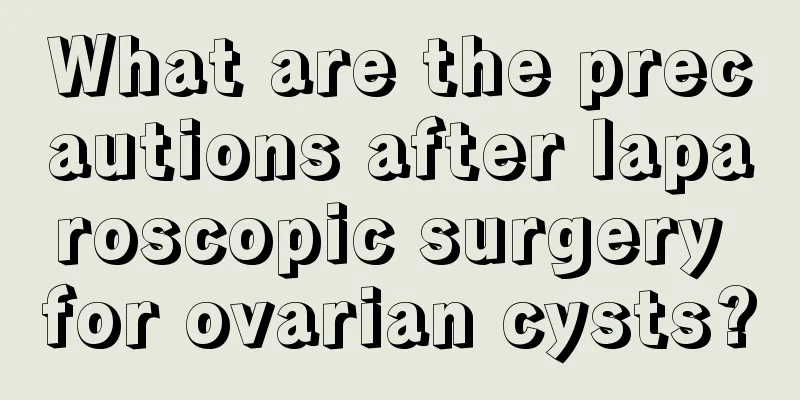What are the precautions after laparoscopic surgery for ovarian cysts?

|
Ovarian cysts are very common. Whether surgical treatment is needed depends on the patient's own condition. If it is malignant, and the cyst grows very fast, is in a bad position, and may affect fertility, then timely surgical treatment is required. Generally, ovarian cysts can be treated through laparoscopic surgery. There are some things to pay attention to after the operation, such as controlling the infection, eating a light diet, and getting more rest. Precautions after ovarian cyst surgery 1. If the patient has bleeding symptoms after ovarian cyst surgery, in addition to cooperating with the doctor's treatment, she can eat some foods that can help stop bleeding and astringe. Such as sheep's blood, snails, squid, shepherd's purse, lotus root, mushroom, water spinach, stone ear, persimmon cake, etc. to relieve postoperative bleeding. 2. If the patient develops an infection after ovarian cyst surgery, in addition to actively cooperating with the doctor's treatment, she can also eat some foods with anti-infection effects. Foods such as eel, clams, water, carp, celery, sesame, buckwheat, toon, adzuki beans, and mung beans help control infection. 3. Control the intake of tobacco, alcohol, coffee, tea and other beverages. Also avoid spicy condiments such as chili, garlic, onion, cinnamon, etc. Greasy food and fried food should be avoided. Moldy and pickled food should not be eaten to avoid aggravating the condition. You should also eat less warm food, such as leeks, mutton, dog meat, etc. 4. After ovarian cyst surgery, you can eat more foods with anti-tumor effects. For example, seahorses, horseshoe crabs, turtles, dragon ball tea, hawthorn, purple sweet potatoes, pumpkins, etc. These foods contain anti-tumor ingredients that can be eaten regularly to not only help the body recover as soon as possible but also prevent the recurrence of ovarian cysts. 5. Patients should pay more attention to rest after surgery to prevent recurrence, avoid too much psychological pressure, and do some appropriate exercise after meals. For example, walking and jogging can not only help patients digest, but also keep them in a good mood and help speed up recovery. Ovarian Cyst Treatment Surgical treatment: The treatment of ovarian cysts depends on factors such as the patient's age, whether it is malignant, the location, volume, size, growth rate of the cyst, whether the reproductive function is preserved, and the patient's subjective wishes. 1. Surgical treatment of benign ovarian cysts (1) Ovarian cystectomy: This procedure is often used in young patients, especially premenopausal patients, while preserving normal ovarian tissue as much as possible. (2) Salpingo-oophorectomy: Older patients (over 45 years old) or postmenopausal patients can undergo unilateral or bilateral salpingo-oophorectomy. It is worth noting that in the surgical treatment of larger ovarian cysts, the size of the incision should be ignored and complete resection is preferred to avoid breaking the patient's pulse and allowing the contents to spill into the abdominal cavity or incision. During the operation, attention should be paid to the rapid changes in abdominal pressure that cause changes in the patient's pulse, breathing, and blood pressure. When necessary, infusion or blood transfusion, oxygen supply should be accelerated, and early detection of acute gastric dilatation, paralytic intestinal obstruction, and the resulting water and electrolyte imbalance should be prevented. 2. Surgical treatment of malignant ovarian cysts (1) Most patients are in the advanced stage when they seek medical treatment, so every effort should be made to remove the primary cyst and any visible pelvic and abdominal metastases. Because malignant ovarian cysts are often adhered or infiltrated with the uterus and adnexa, and are closely attached to the pelvic peritoneum, the uterus and tumor are often removed in one piece along with the pelvic peritoneum in a rolling carpet style, such as omentectomy, partial intestinal resection, partial bladder and ureter resection. (2) Consider placing a catheter in the peritoneal cavity to facilitate the postoperative intraperitoneal injection of chemotherapy drugs. |
<<: What are the symptoms of chronic pelvic inflammatory disease
>>: Is it easy for the uterus to be anterior and the placenta to be previa?
Recommend
What can you cook with celery? What does poisonous wild celery look like?
Celery has a long history of cultivation and is o...
Is bare-hand pelvic floor massage reliable?
The woman's pelvis is a very important positi...
Symptoms of subendometrial fibroids
Uterine fibroids are a common gynecological disea...
What are the symptoms of breast hyperplasia
When breast hyperplasia occurs, the female body w...
How to ferment bean cake fertilizer quickly? How long does it take for the bean cake to be used?
Bean cake fertilizer is a very common organic fer...
How to isolate at home during the novel coronavirus outbreak? Things to note when isolating at home during the outbreak
We all know that home quarantine is an important ...
Can I drink Houttuynia cordata boiled water every day? What will happen if I drink Houttuynia cordata boiled water every day?
We all know that Houttuynia cordata is a common f...
Will I have miscarriage if I'm in a bad mood during early pregnancy?
Many pregnant friends experience depression durin...
ALS is known as the "first of the five incurable diseases." Is it an incurable disease, or is there hope of a cure?
Introduction In the past two years, ALS has becom...
What are menstrual blood clots?
In daily life, we often see young women wearing v...
How to take photos of buildings and the big moon How to take photos of the super big moon
The supermoon is a very special astronomical phen...
What causes urethral pain in women?
Urethral pain is a common disease among women and...
What is the matter with the hardness in the breast?
Because breast cancer has become a serious proble...
What to eat for women with low blood sugar
Patients with hypoglycemia will experience sympto...
Do women's breasts continue to grow as they grow older?
Many women hope that their breasts can develop ag...









